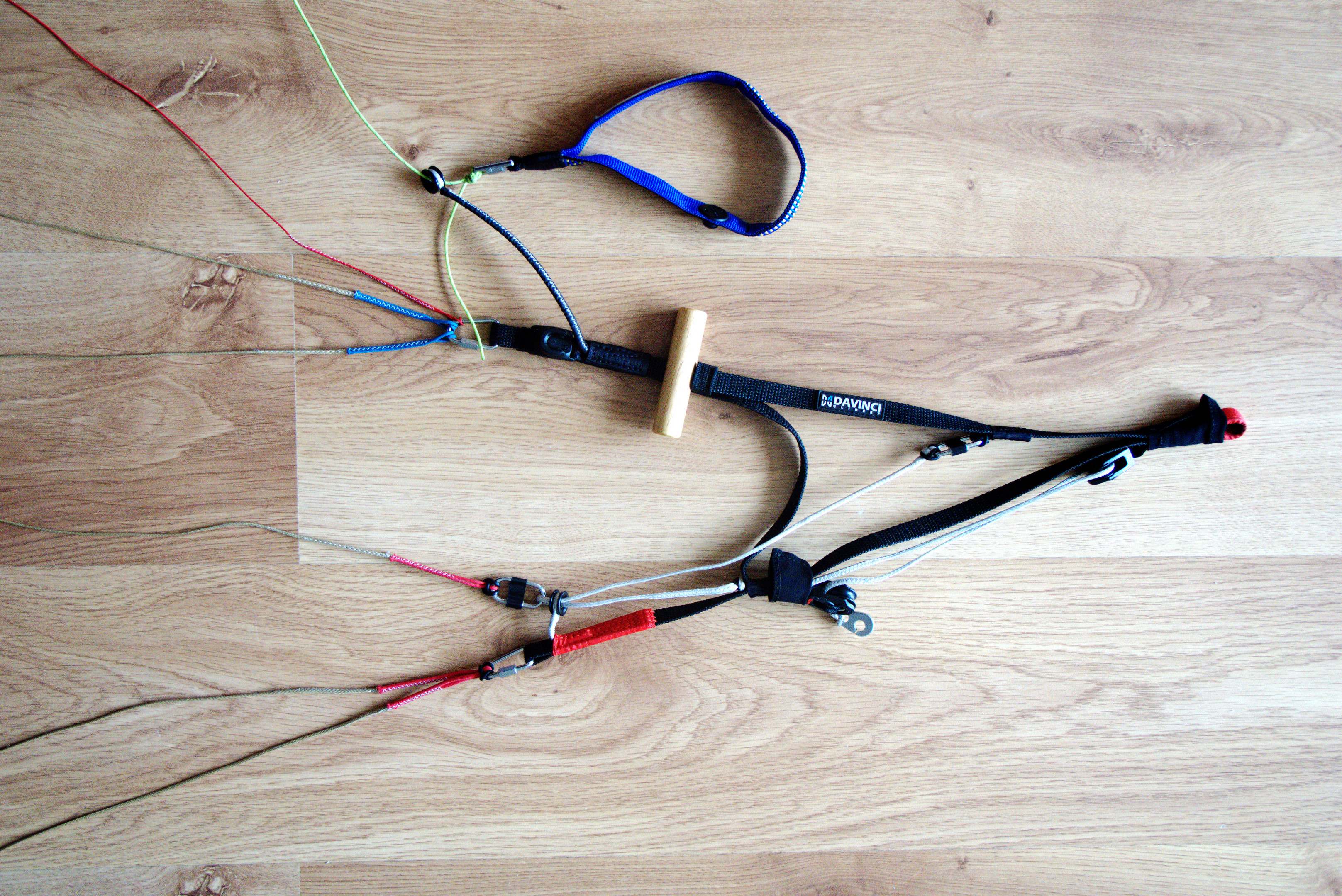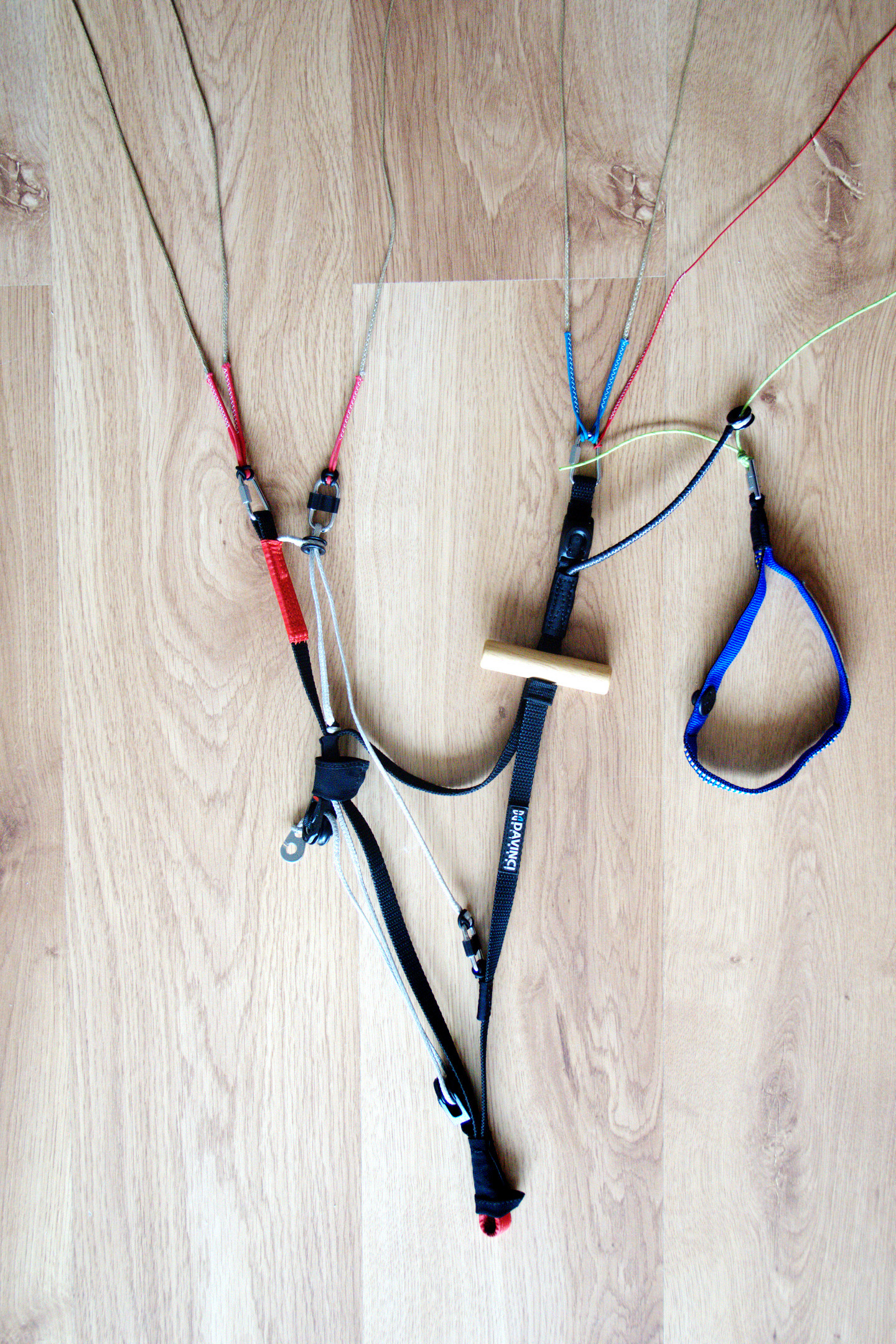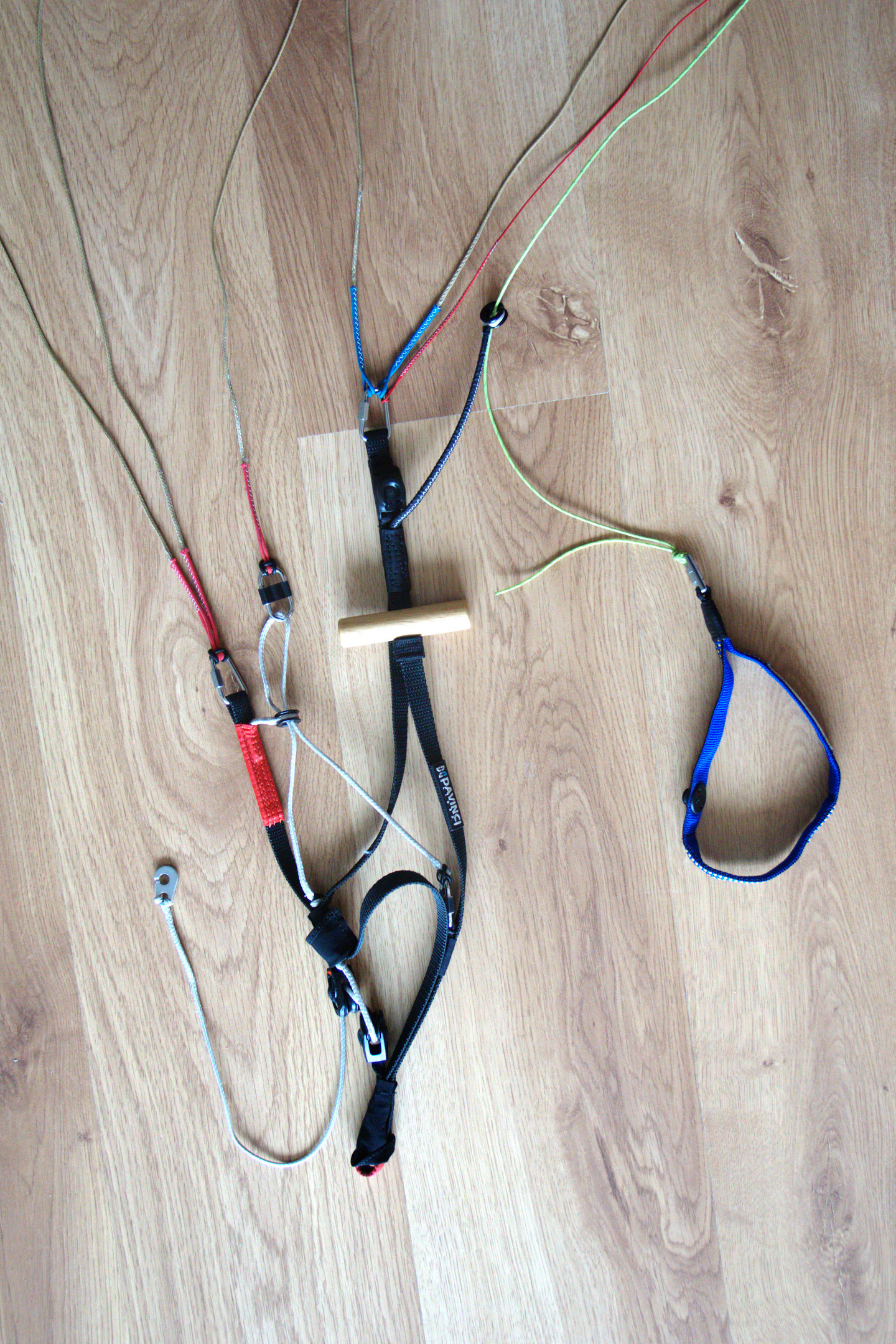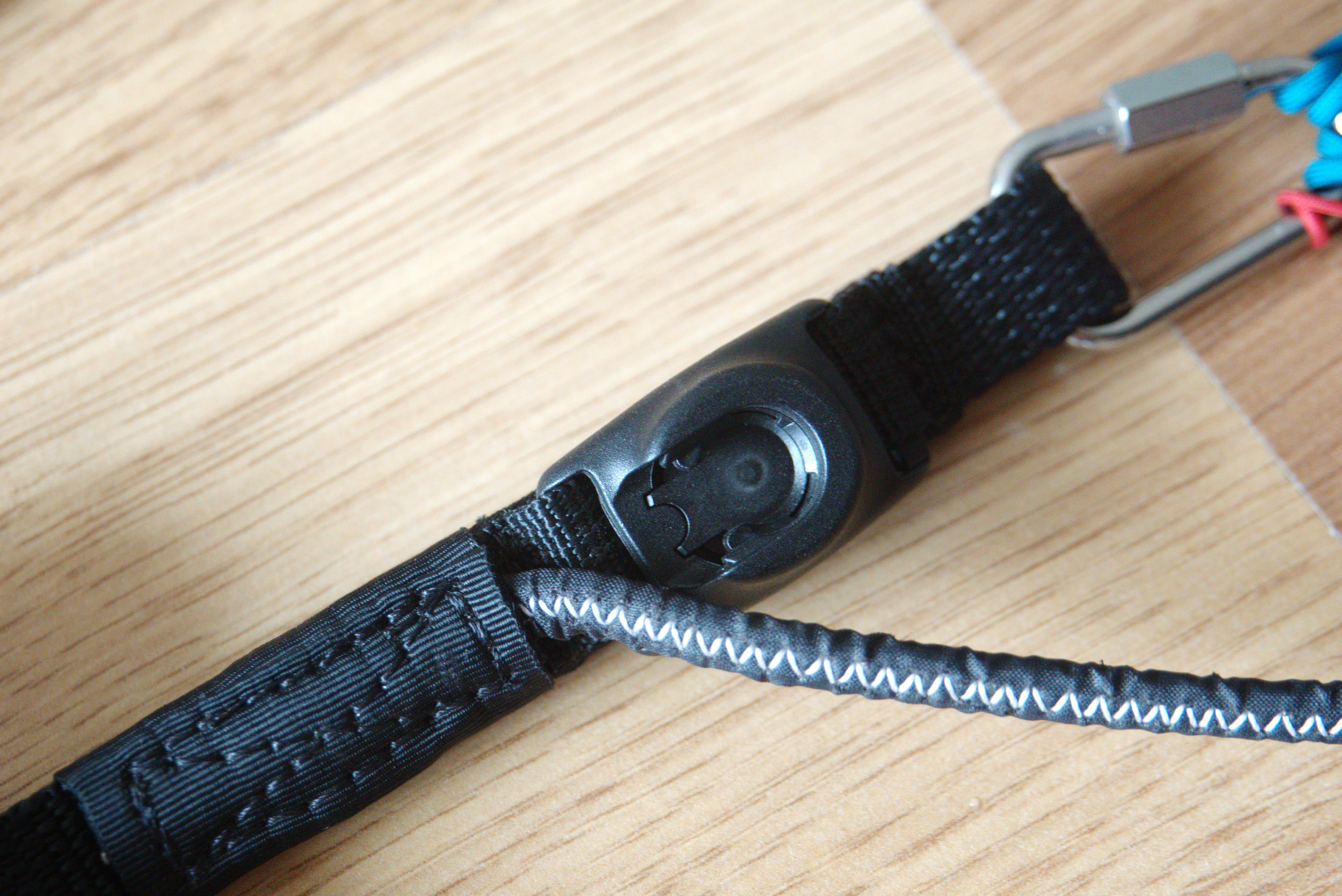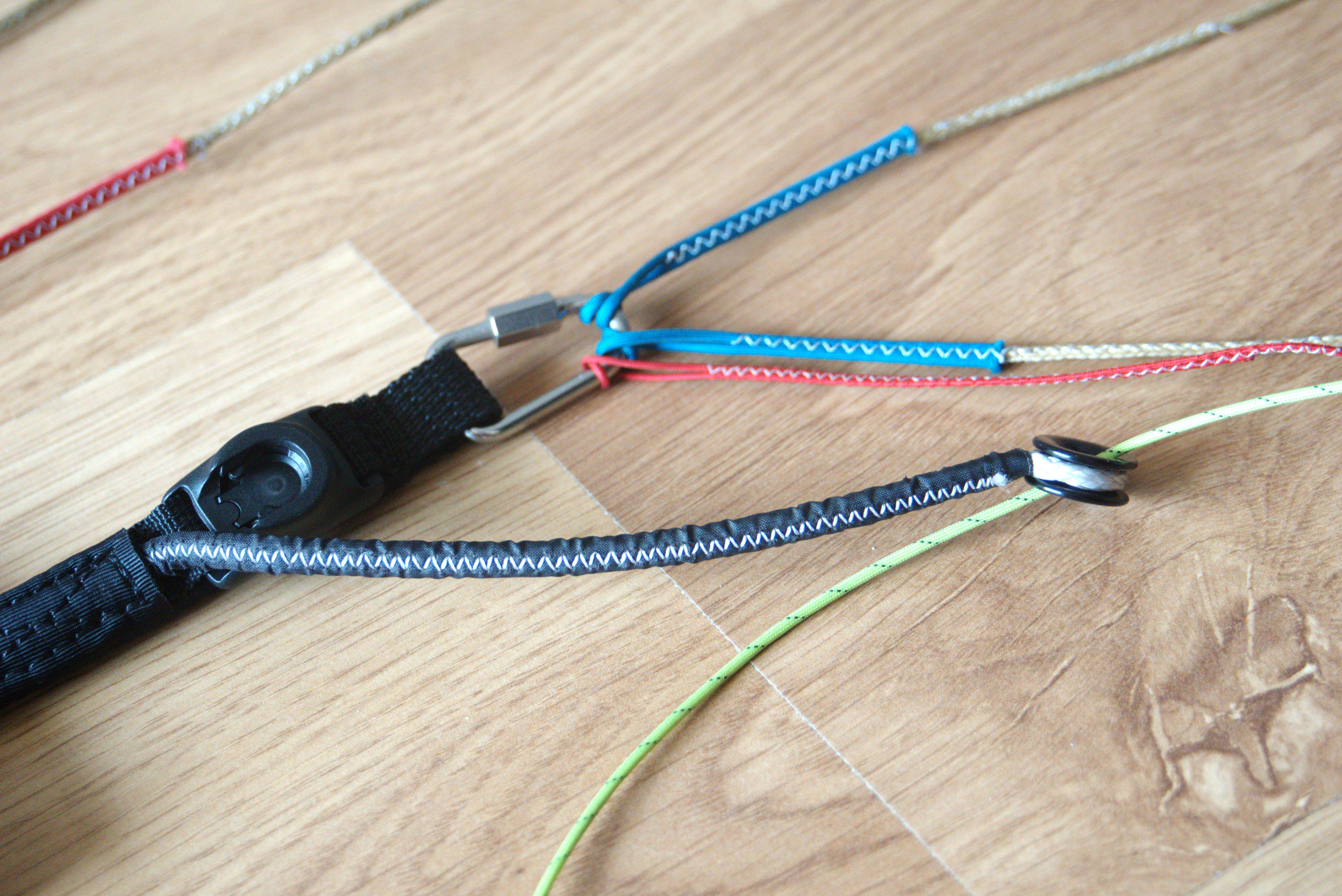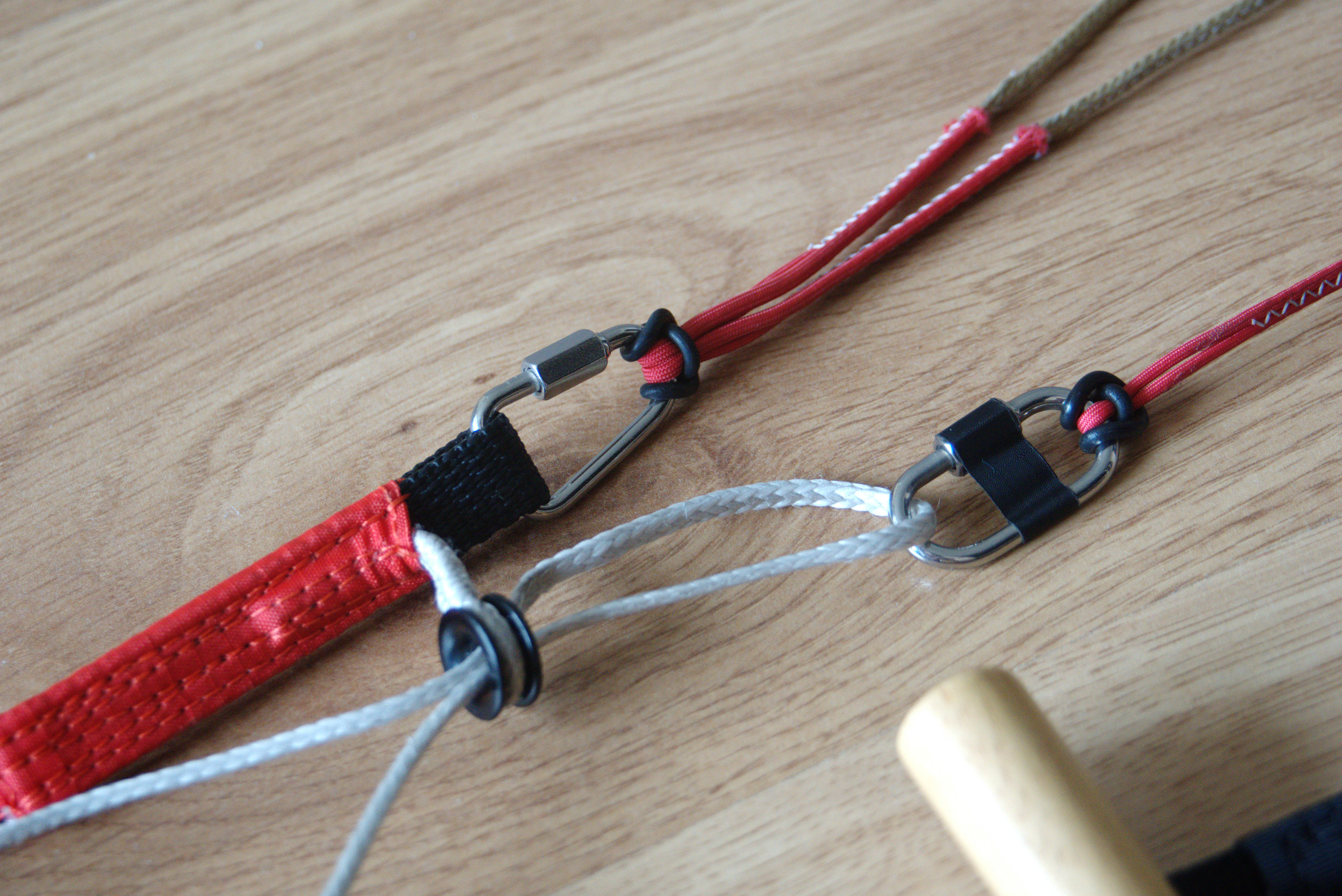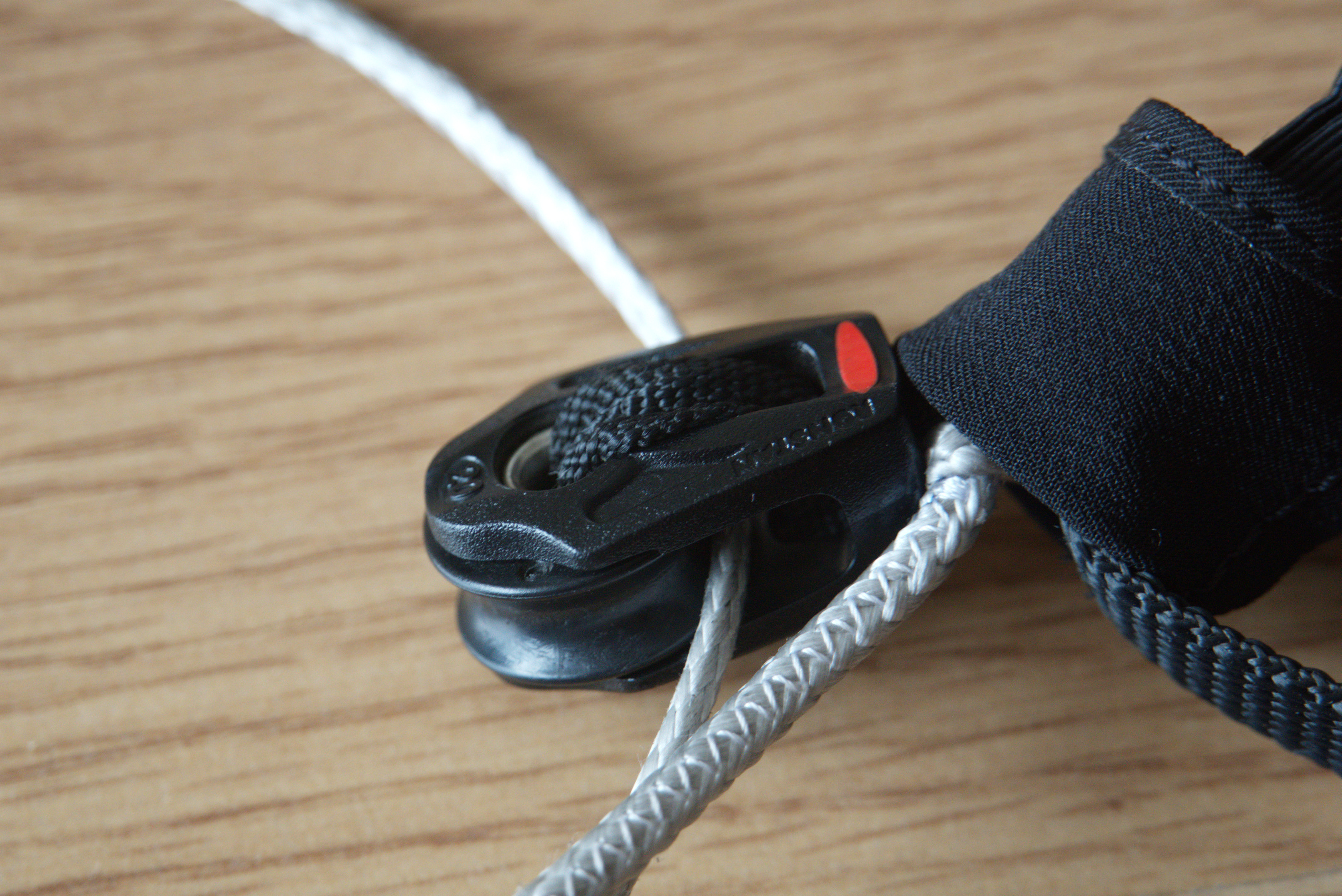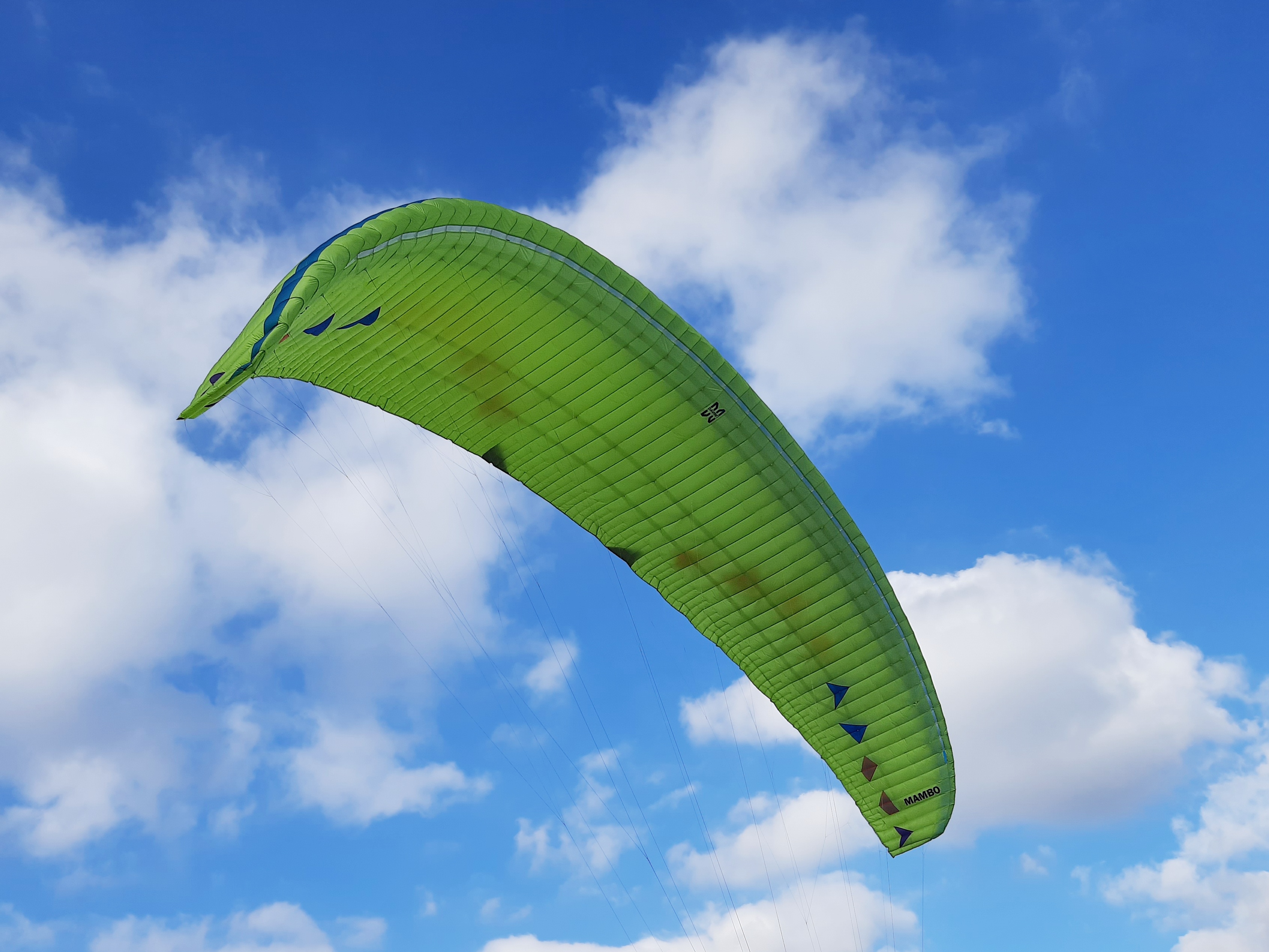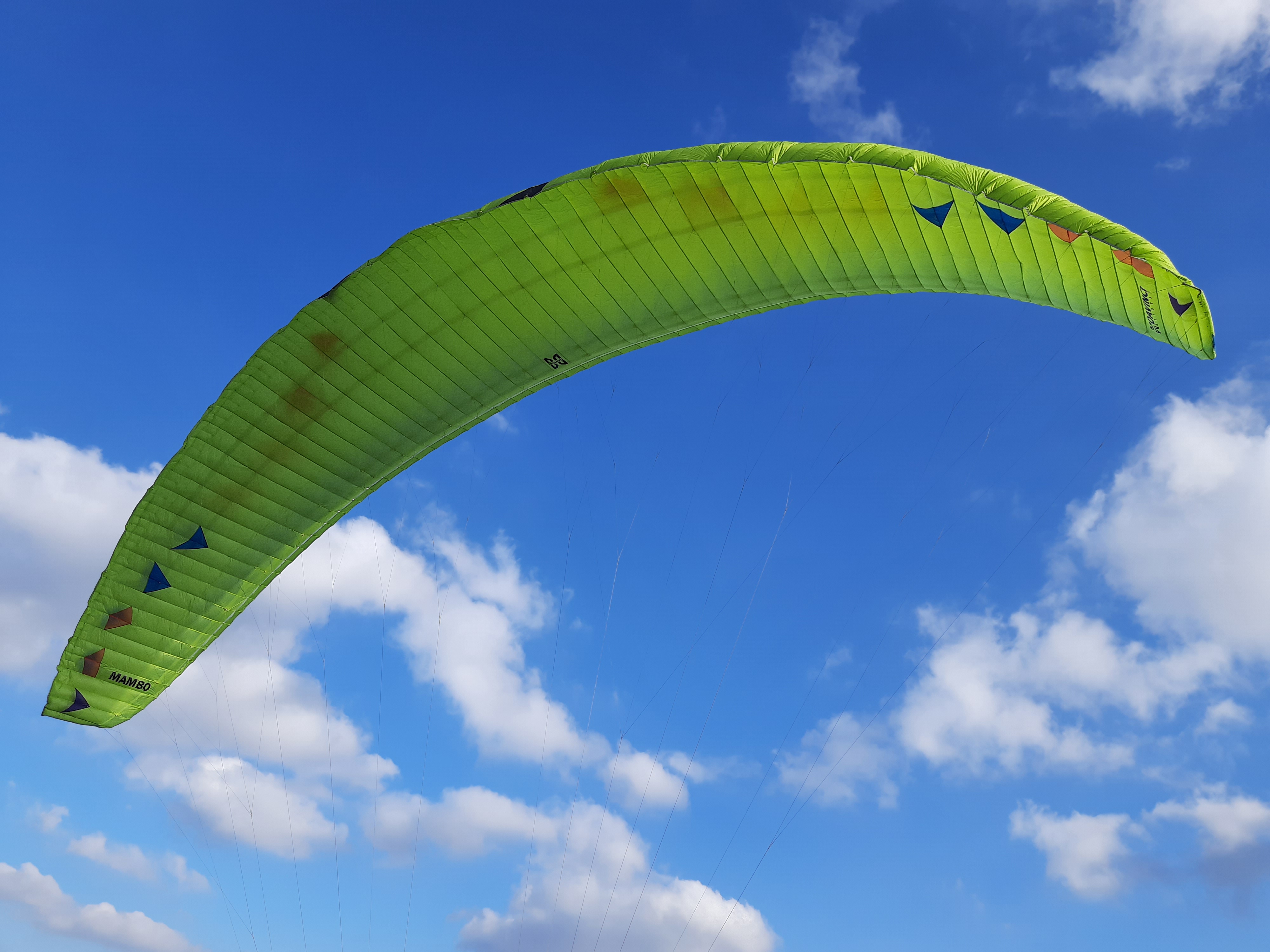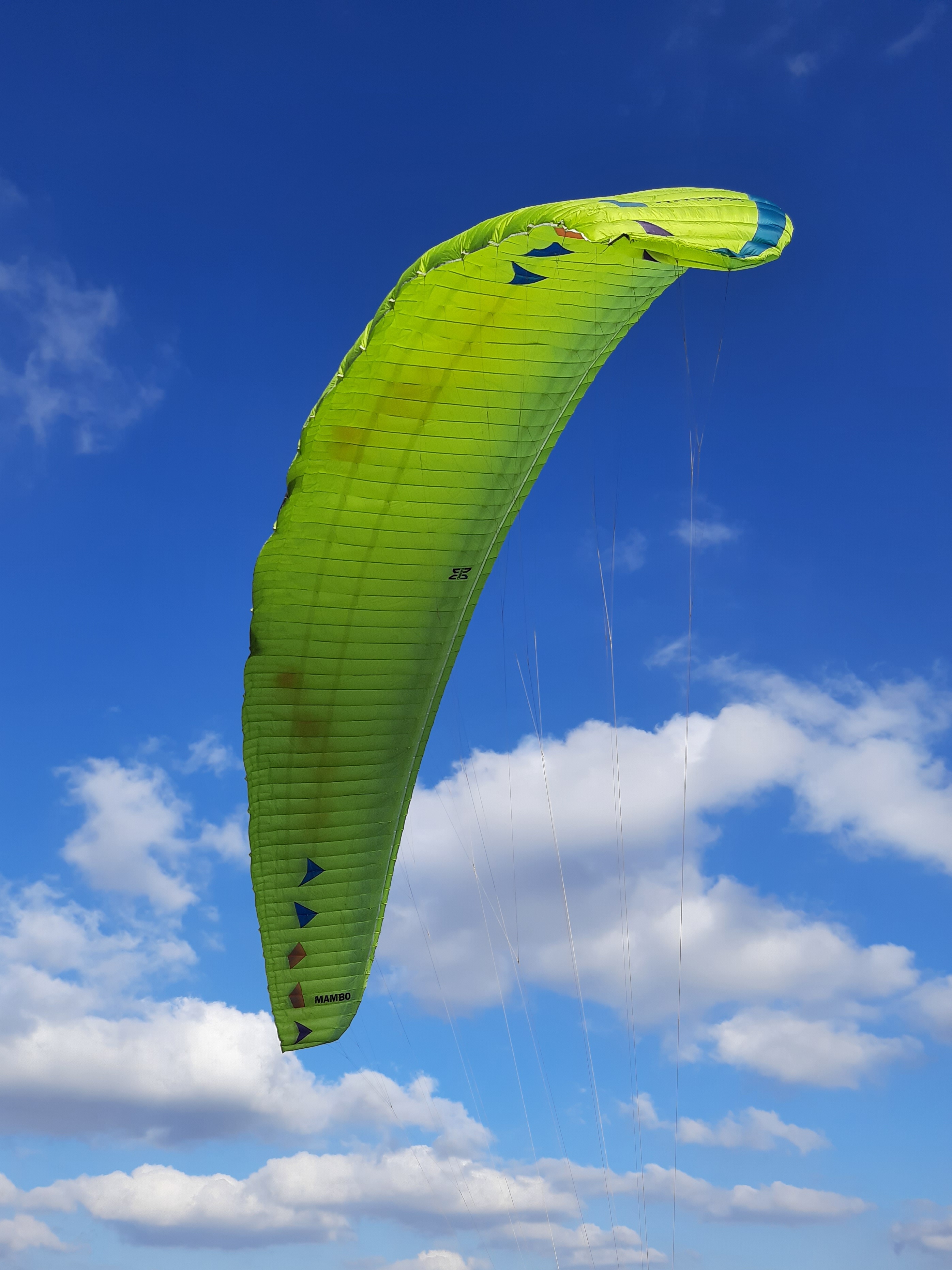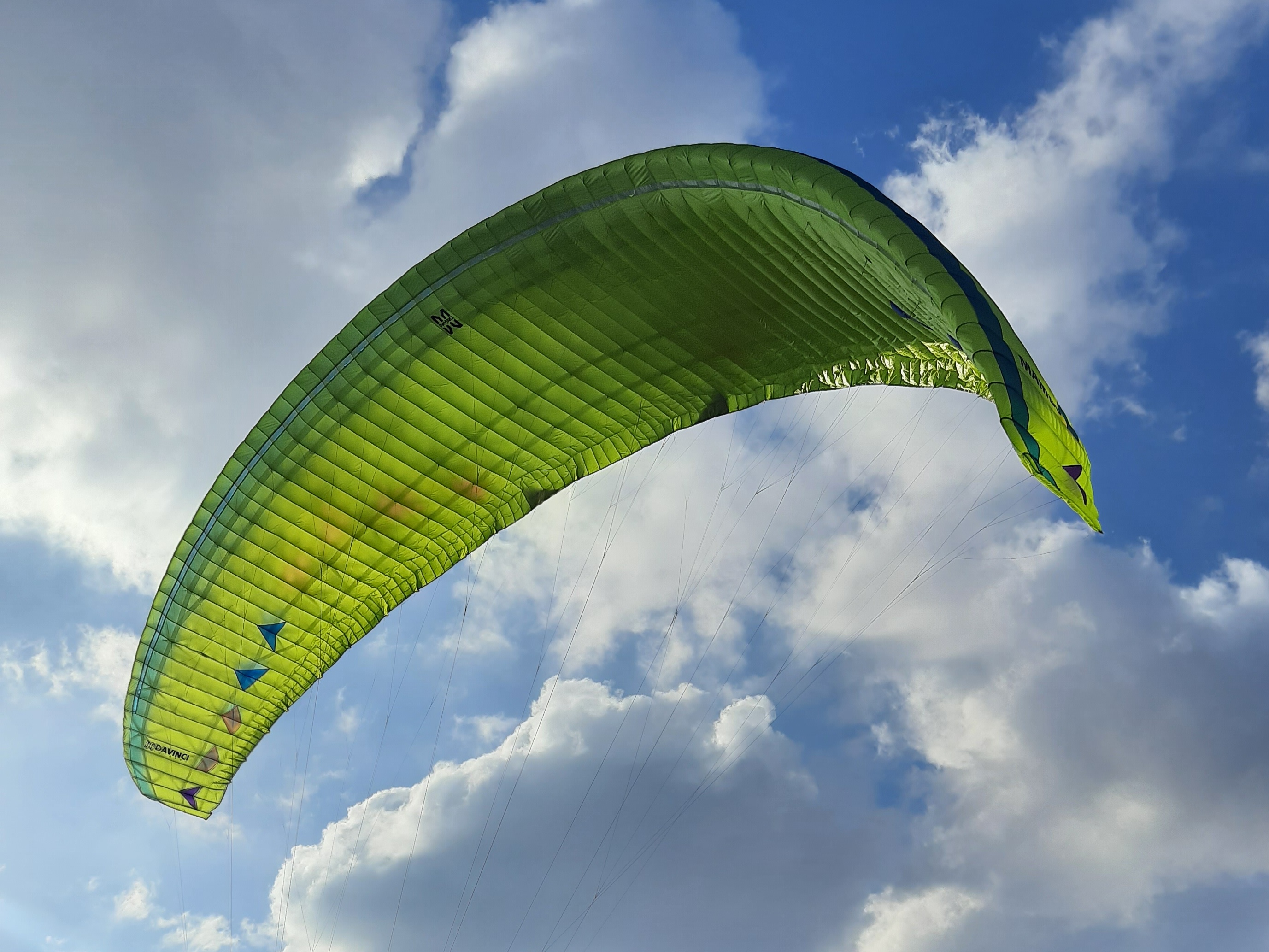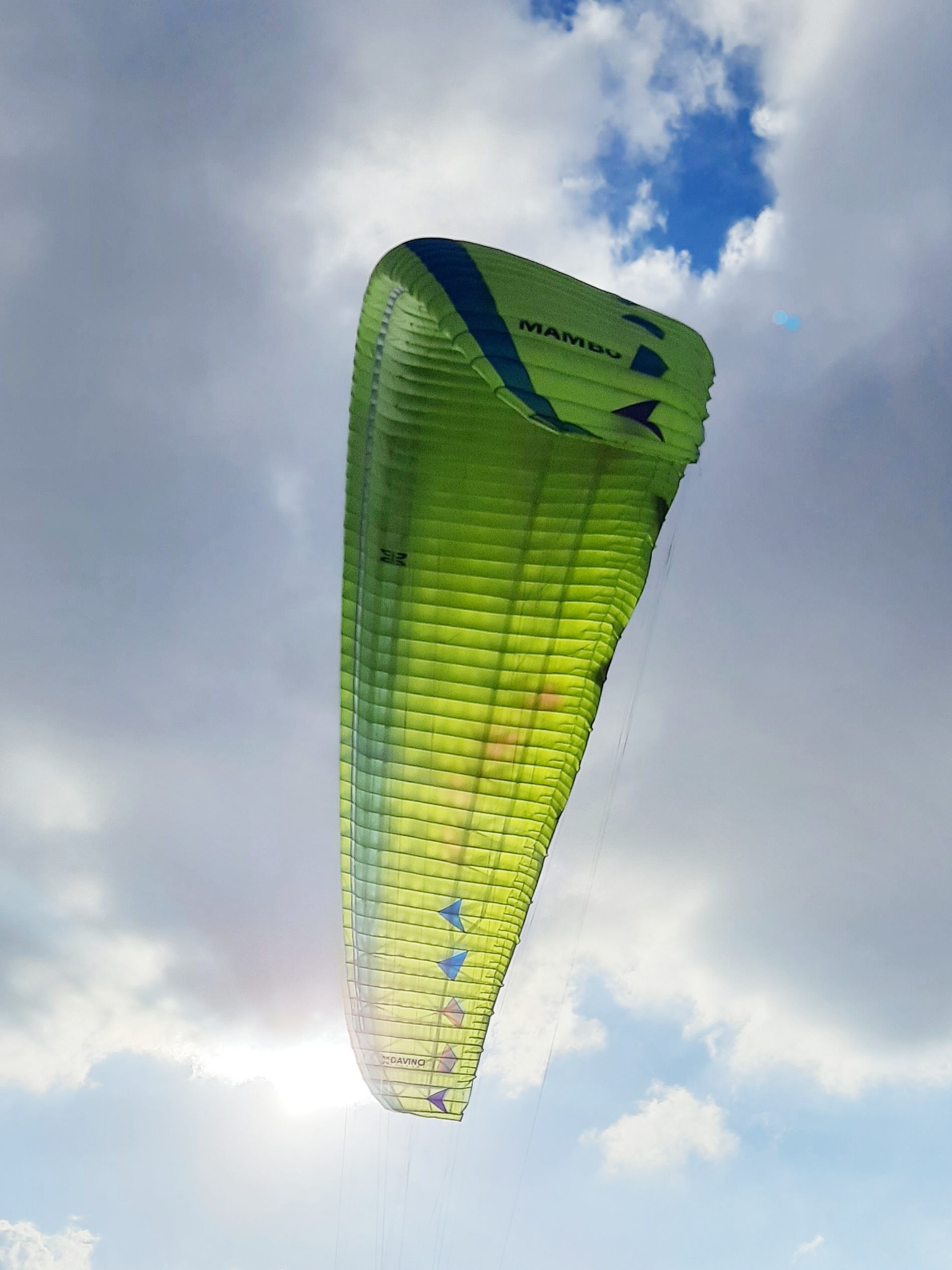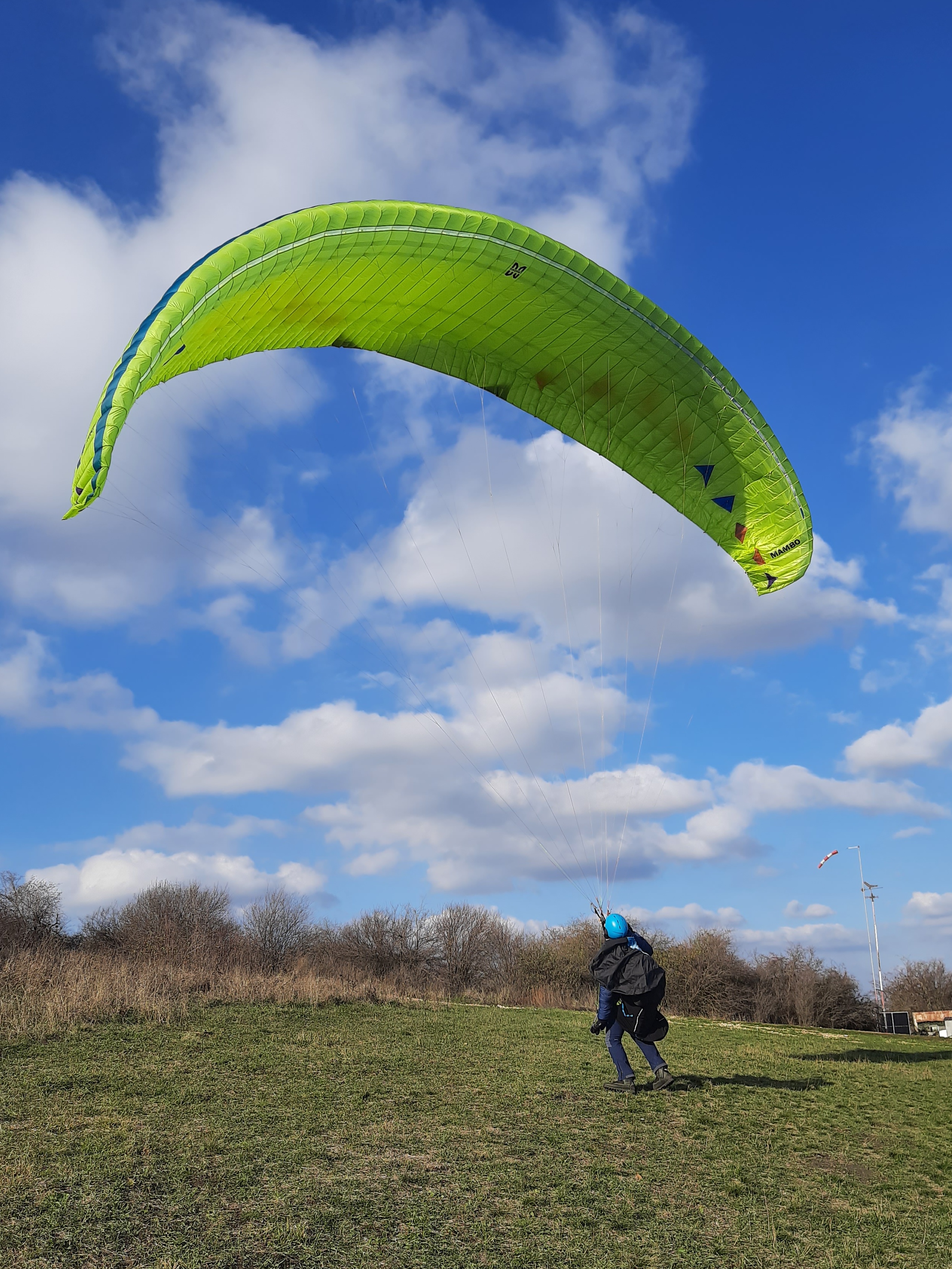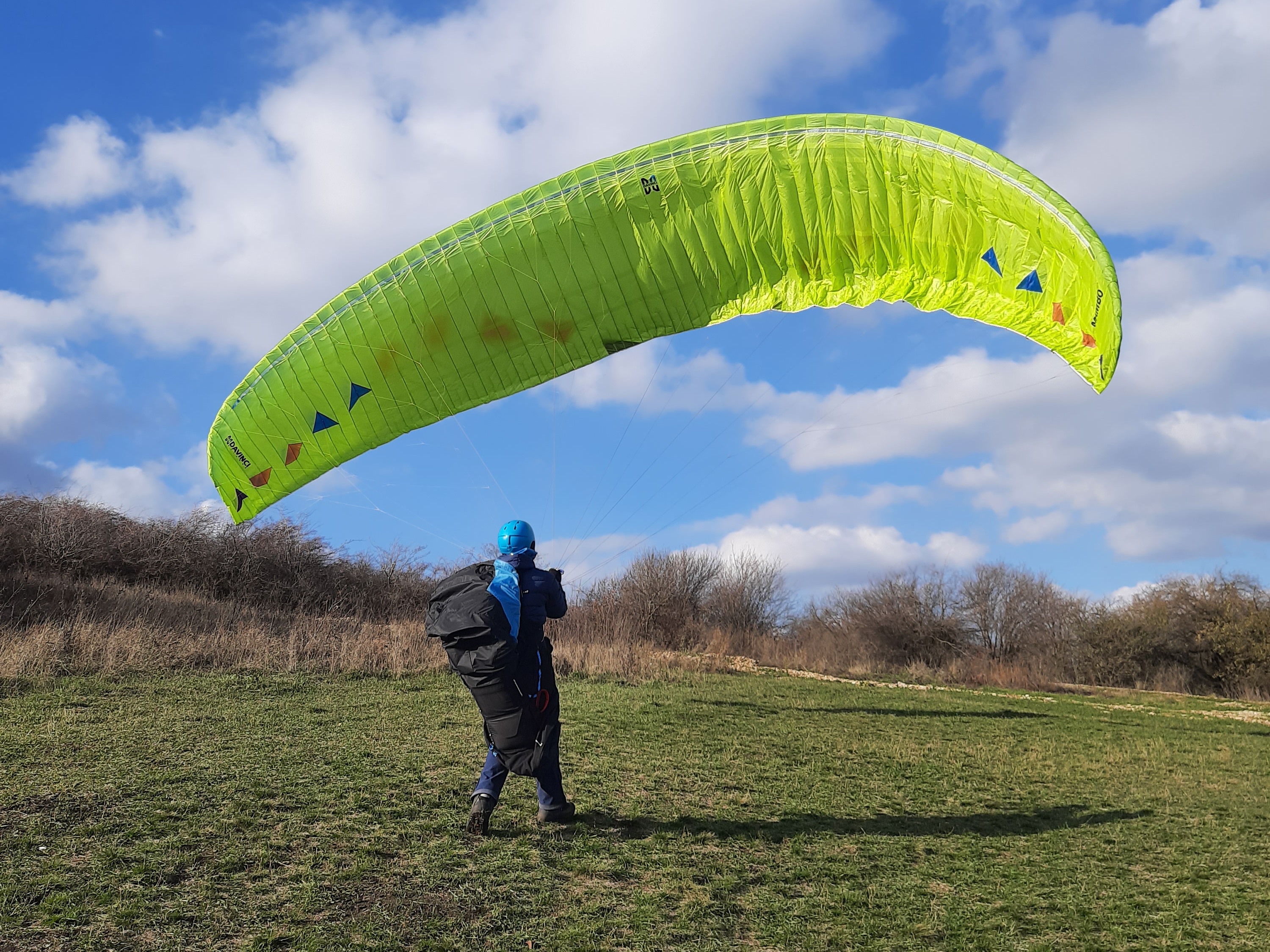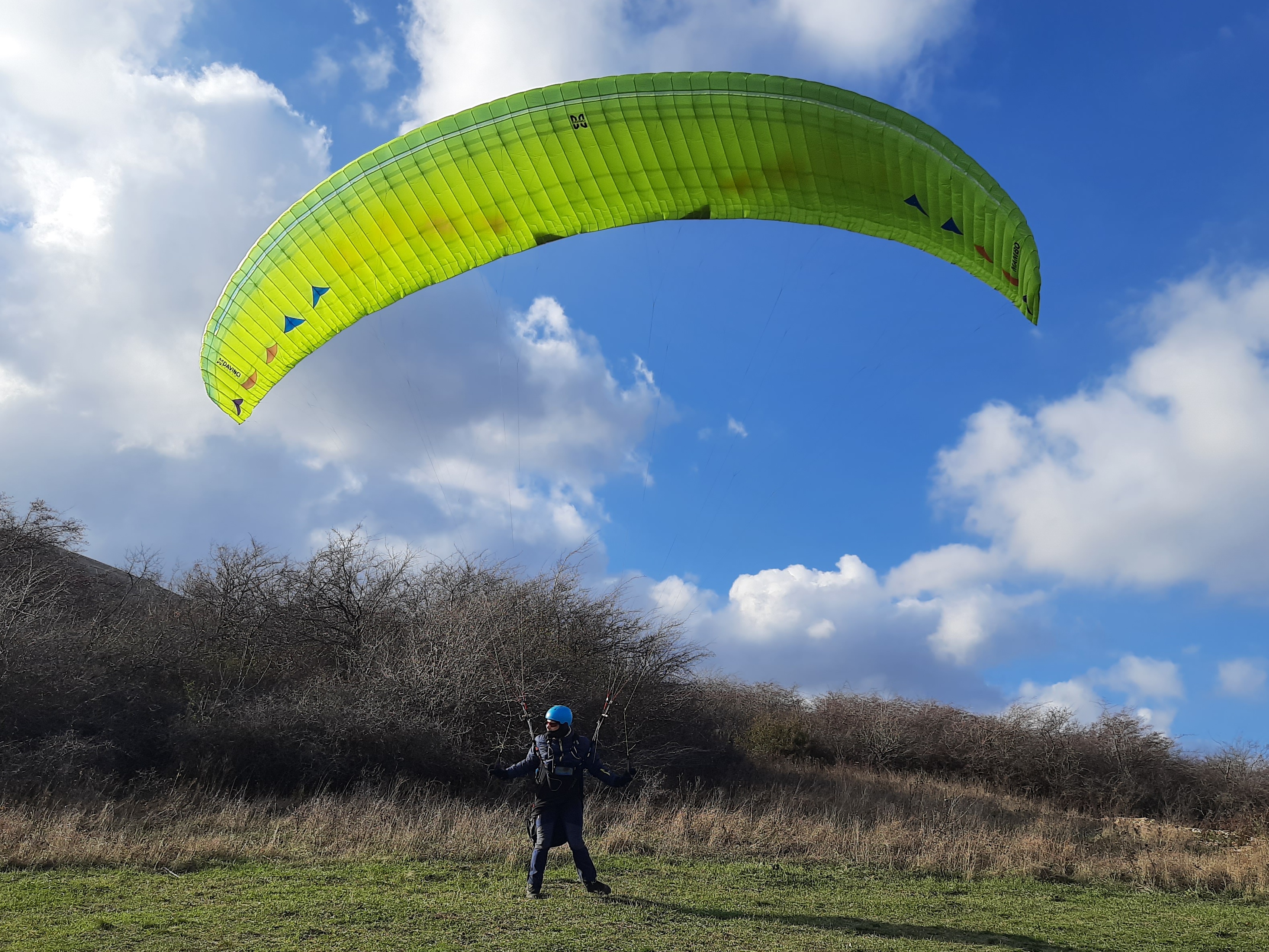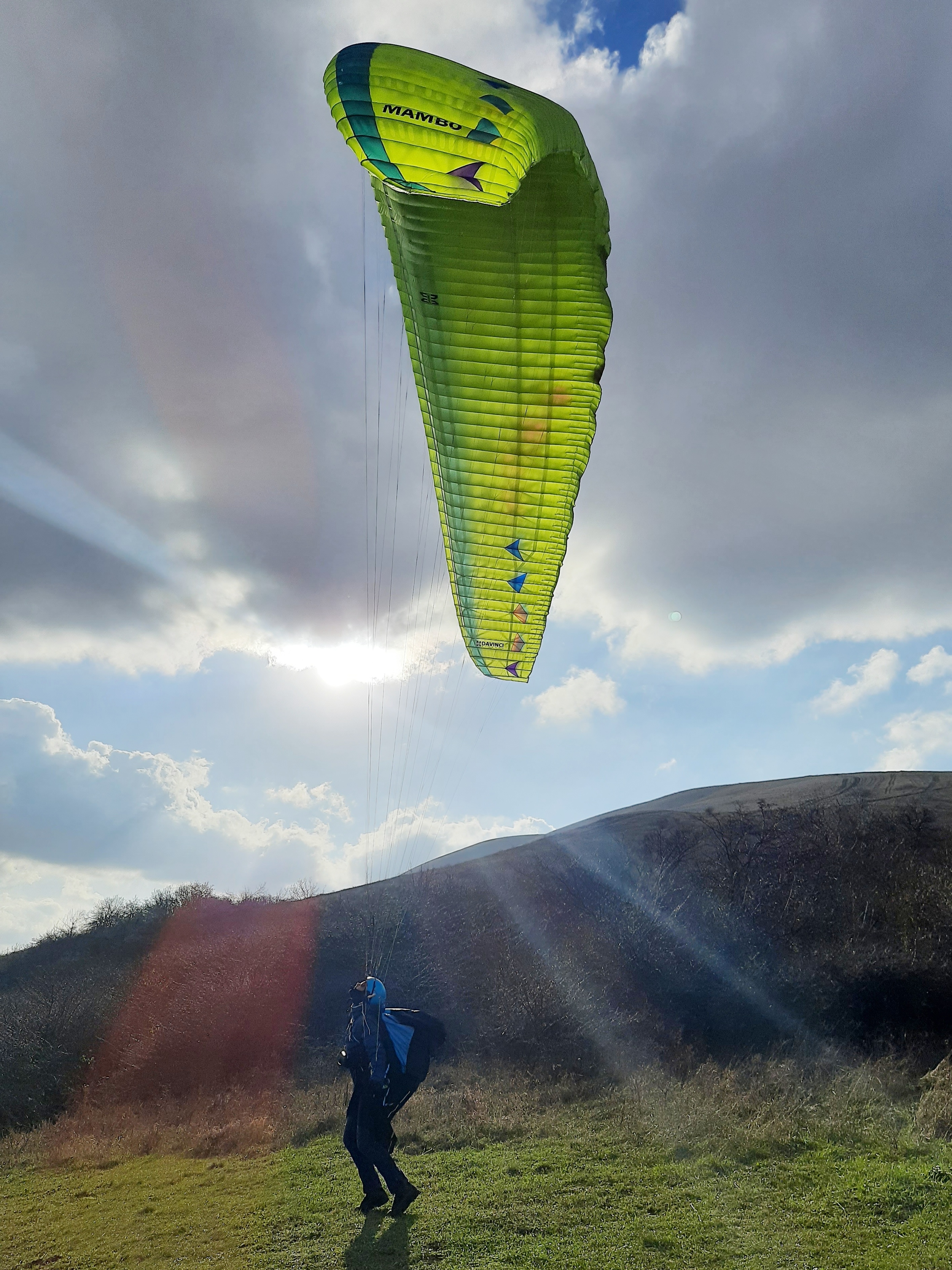The wings of a young company are like a young wine. Bright, ambiguous, and different every time. But sooner or later, maturity comes, bringing stability and predictability. DaVinci is a young company, and its first wings were very different. Mambo, in my opinion, marks the beginning of maturity. People will buy this wing knowing exactly what it is, who needs it and why. Who and why? Read below!
Construction

Risers
The first impression is the most important. And it is made by the risers, which I immediately take out of the box when I unpack another glider I am testing. At first glance, they're typical DaVinci risers, but on second or third glance, you notice some interesting details. The speed system travel is relatively long, and there is a limiter, just like on the CCC marked gliders. The construction and materials used are very similar to Ozon's - everything is simple and rational, sometimes even too simple to the detriment of the first impression. The Niviuk and Advance risers look and feel less budget. However, it's not without little niceties. The brake line is well made - moderately stiff, moderately long, with a nice ceramic ring instead of a heavy, uncomfortable pulley. The brake handles are attached to the rear risers on handy magnets with protection against accidental detachment, which is nice. The handles themselves are quite simple: soft, without a hard pad for the fingers, but with swivels. The handles on the backs are also not without a touch of budget: simple polished wooden cylinders with no way to remove them and/or move them up and down. The size and grip, however, are quite comfortable. The pulleys of the speed system are of high quality, with bearings. The moving parts of the risers, including the speed system, are made of thick, slippery Dyneema. The lines are attached to the steel connectors with good old rubber rings that need to be replaced from time to time. All in all okay, but it could be better.
Lines
This is about to get interesting! This is not a lot of lines, even by two-liner standards. The lines scheme is A2A'1B3. DaVinci claims that Edelrid 8000U unsheated aramid is used in all tiers. The lines have an impregnation for UV protection, but it is not visible to the naked eye. The lines have the natural color of aramid. The use of aramid in all tiers is an unusual solution, most often dyneema is used in the upper tiers. The stitching is clean, there is nothing to pick on. There are protective braid eyelets in the area of the connectors. There are also factory loops on the rear, which should be loosened after 40-50 hours of flight time to compensate for shrinkage of the rear lines.
Canopy

Build quality
Surface smoothness
And now things get really, really interesting! DaVinci is very fond of non-trivial technical solutions, and Mamba is full of them. The first thing that catches your eye is the huge shark-nose, like the fiercest sports wings. The attachment points of the front lines are noticeably shifted backwards - a hint that the wing is optimized for high speeds. Inside the narrow intakes is a band codenamed Smart Nose. It works like a valve, preventing air from leaving the wing when it threatens to collapse, but not preventing air from entering. All of this has been seen on DaVinci gliders and some other gliders. But the Mamba also has something completely new. The Smart Snake technology! "Smart Snake" is a kind of two-dimensional nitinol spring that gives each rib extra stiffness. The nitinol is quite thin, but its presence is immediately noticeable after unpacking the wing. The springy nerves give the Mamba some volume on the ground. In calm conditions this is more of a plus - the wing fills up faster and easier. But in strong winds the "smart snake" can show its character: if the wind hits at least a few open fences, the Mamba starts to crawl for take-off, forcing the pilot to brake. Unusual behavior!
The wing shape of the Mamba, on the other hand, is perfectly normal, classic, without any peculiarities. The AR is a bit higher than typical for EN C 2-liners: 6.6. The number of sections is also higher than usual. The internal structure of the Mamba is quite complex, it is obvious that the designers tried to smooth the wing while keeping the number of line attachment points to a minimum. The result is good, but not perfect. The front of the Mamba is quite smooth, but the back of the chord is not so smooth, it is slightly bumpy. Interestingly, the designers used both plastic and nitinol to make the Mamba rigid. At the time of writing this review, I have only come across this solution a few times. Cutting and sewing gave no cause for complaint. The graphic design will not make anyone happy, but it is original and recognizable.
Takeoff and groundhandling
Groundhandling

It's specific. The large mass of the wing is immediately noticeable. In light wind, the Mamba launches confidently but a bit laboriously, slows down a bit at about 80 percent, but eventually comes into flying position. In light winds the Mamba, like other heavy wings, tends to slip sideways rather than fall backwards. In stronger winds, the Mamba will take off quietly and confidently, slightly overtaking the pilot, and will lock into the flight position. In strong winds, the Smart Snake, which gives the unfolded wing some volume and fullness even with no load on the front rows, starts to cause problems. In high winds this can lead to premature inflation and launch. Therefore, in strong winds, it is highly desirable to keep the Mamba in a "rose" position and expand it to full span just before launch. The Mamba passes the ear-to-ground test, but the Cobra is rather stubborn - you need at least 3-4 m/s wind for this. Reactions to weight shifts and brakes are smooth, control efficiency is moderate.
Takeoff
Nothing specific. The trim speed is surprisingly low, so the Mamba takes the load quickly without requiring a long run-up.
Flight

Glide
Perhaps the most subjective part of this review. Unfortunately I did not have the opportunity to test the full speed range of the Mambo side-by-side with other EN C's. I can confidently say that at trim speed the Mambo is not significantly different from EN C rated two and three line wings. I was able to fly the Mambo in parallel with some relatively modern C and D class gliders with the speed system partially engaged; there was no significant difference in glide, but above 50% speed system travel the Mambo flies away from the pack very quickly. Of course, at maximum speed the Mambo's L/D ratio drops significantly, but not so much as to be a problem for XC flying.
Accelerated flight
Speed gain
Speed system effort
Speed system travel
Comfort at high speed
Shock and awe, dear readers! During the summer of 2024, my ideas of what speeds were possible in the EN C class changed several times in a row, but the Mamba managed to really surprise me. I'll start with the numbers, which are more honest than feelings. The speed gain at 50% of the speed system stroke is about +17...+18 km/h (many wings with EN C label add that much at full throttle). And at 100% of the stroke... And at 100% stroke I got very, very impressive +25...+27 km/h from the very first measurements. At least not slower than the previous leader of my measurements — Swing Libra RS. But these were measurements in quite strong weather. The result was quite stable, the speed was maintained for a long time, and the only limitation was the turbulence, which Mamba tolerates surprisingly calmly. I made an additional series of measurements in calm evening air and it was very useful. It turned out that Mamba is very slow to gain speed, and it takes at least 20-30 seconds to stabilize. Preferably a minute. And in such laboratory conditions, Mamba revealed itself to the full! The speed gain at 100% throttle reached an impressive +30 km/h! This is not only a class record. At the time of writing, it's the absolute record for speed gain I've ever achieved in any of my test drives! Just to understand the situation — my personal Niviuk X-One adds about +25 km/h. Unfortunately I wasn't able to do a head to head between these two wings — but it's unlikely that the X-One can beat the Mamba at 100% throttle. The glide of a CCC-certified wing will certainly be higher — but we're only talking about top speed for now.
It looks like we can stop there. But I have more good news! Despite its impressive top speed, the Mamba is very comfortable at any speed. I flew for a long time with 50-70 percent throttle, flashing thermals up to +4 on the averager — the Mamba did not even flap its "ear".
But that's not all. Mamba's throttle is not too long, and the load on the legs is quite comfortable! You can see that DaVinci has optimized the Mamba for high speed flying. Impressive!
Soaring and sink rate
Sink rate in straight flight
Sink rate in spiral
Fast wings often don't have much soaring talent. But the Mamba is only fast on the throttle, the trim speed of this wing is slightly below the market standard. Perhaps this is one of the reasons why the Mamba soars so convincingly and is easy to hold in light and narrow lifts. And it's caused by the Mamba's sink rate, not its maneuverability. Another possible reason is the rather high glide ratio, but this is already a matter of conjecture. The bare facts are that the Mamba performs quite convincingly both in weak ridge lifts and in narrow, strong thermals.
Turn ability
Brakes efficiency
Weight shift efficiency
Rear risers control
We're approaching our subject's first weakness. No, not that it's not agile. It is just enough — but not more. Most of the time I flew the highly loaded Mamba, and even in this case the Mamba's reactions to the controls were quiet. It is quite possible to get this wing into a big roll, but it requires some persistence on the part of the pilot in the form of ample and persistent control input. This applies to both braking and weight shifting. The Mamba's brake load builds up quite quickly when the arms are lowered, and if the weather requires frequent and vigorous roll changes, the arms can get tired. But the good news is that the Mamba holds the roll well and reliably, and once the roll is there it requires almost no control, even in brisk weather. Wingovers and spirals aren't something the Mamba does so readily, let's say without fire. Another indicator of the wing's responsiveness to control is top landing, especially if it is an uncomfortable part of the slope and the weather is quite windy and turbulent. I have done this many times and generally succeeded, but instead of a few energetic movements close to the ground, I got a kind of measured classical ballet.
Special attention should be paid to the reactions of the rear riser control — it's very critical for a wing as fast as the Mamba. And in this respect the Mamba unfortunately did not shine again. The load on the rear risers is very high, which makes them uncomfortable to work with, and their efficiency is, shall we say, unimpressive. You have to pull the rows back a lot to get any meaningful effect, and working them up and down puts a lot of strain on your arms. The good news is that the Mamba is a very quiet glider that does not require a lot of riser work, even in choppy conditions.
Comfort and feedback
Comfort
Feedback
Comfort is another strong point of the Mamba. It is probably one of the most comfortable EN C wings I have ever flown. And when it comes to EN C two-liners — in this particular group of wings, the Mamba claims to be the leader in comfort! There is surprisingly little difference between flying in smooth, calm ridge lift and in +4 thermals. The Mamba is quite damped in all directions, which is unlikely to impress the modern, demanding pilot. What is even more interesting is that the Mamba's high level of comfort is maintained even at full throttle. And the funny thing is that despite its name and the Smart Snake technology inside, the Mamba is not prone to snaking at all! The wobblings are present only in trace amounts and only occur during serious chattering.
It would seem that such a prohibitive comfort should "kill" all informativeness. Fortunately, no! It is saved by the "special two-liner magic" that is pleasant and unobtrusive in the Mamba. There is a smooth acceleration on the far periphery of the current and pronounced changes in the load on the brakes when searching and centering. There are two interesting features that set the Mamba apart from most competing wings. When entering the lift, Mamba gets into the roll of the required sign, it is not thrown out of the flow, but on the contrary, "throws" inside, which greatly facilitates piloting. The second peculiarity is that when working in the lift, if the load on the arms suddenly decreases, with a very high probability it means that in a second or two the Mamba will fall out of the lift. In principle, these two features are enough to center quickly and effectively. It is also important that the Mamba "speaks" to the pilot in a simple and clear "language" that does not require a long learning curve. Switching from three-liners to Mamba can be done in a few hours.
Class record in speed increase at 100% speed system, outstanding comfort, moderate maneuverability, complex construction, high mass.... Yes, the Mamba is definitely built for competition. I believe that at the time of this review, there is no other glider that can compete with the Mambo for the series class podium. Outside of competition, the Mambo will be of interest to those who are willing to carry a heavy and bulky backpack. This wing is definitely not for X-Alps, not for hike-and-fly. It's suitable for mountain flying but it could be better to have an easier launch and a sharper response to the controls. But in its target niche, the Mambo is an almost uncompromising offer. Of course, it's always the pilot who wins, not the glider. But a lot depends on the glider, too.
The entry threshold is surprisingly low for such an ambitious glider. This is largely due to the Mambo's comfort and straightforward handling. I think the Mambo can be considered a first two-liner, and I estimate the minimum flying time required to be 100 hours. Is this glider to my taste? Probably not. I like more maneuverable gliders with sharper reactions. But if I want to compete for prizes in serial class competitions - the Mamba would be my preferred instrument.
Pros
- Record speed increase with the speed system
- Very smooth, comfortable ride in bumpy conditions
Cons
- Heavy loaded, low efficiency rear risers
Peculiarities
- Специфично ведёт себя при старте в очень слабый и очень сильный ветер
Thanks
I would like to thank Rinat Sabitov for providing a paraglider for the tests.
Copyright
- Photo / video: I. Tarasova, S. Grishchenkov, K. Fedorov, A. Tarasov
Technical data
| Flat area, sq. m. | 24,5 |
| Flat A.R. | 6,6 |
| Flat span, m | 12,7 |
| Projected area, sq. m. | 20,2 |
| Projected A.R. | 4,7 |
| Projected span, m | 9,75 |
| Cells, total | 67 |
| Cells, closed | 12 |
| Flattening, % | 17,5 |
| Cord max, m | 2,36 |
| Cord average, m | 1,93 |
| Lines height, m | 7,35 |
| Lines scheme | A2A'1B3C3 |
| Takeoff weight, kg | 85-105 |
| Glider weight, kg | 5,3 |
| Size | M |
Materials and components
| Upper surface, leading edge | Myeongjin | MJ 32 MF |
| Upper surface except leading edge | Myeongjin | MJ 32 MF |
| Bottom surface | Porcher | E3H 27g |
| Ribs, supported | Myeongjin | MJ 32 HF |
| Ribs, unsupported | Myeongjin | MJ 32 HF |
| Diagonal ribs | Myeongjin | MJ 32 HF |
| Lines, upper cascades | Edelrid | 8000U |
| Lines, middle cascades | Edelrid | 8000U |
| Lines, main (lower) cascades | Edelrid | 8000U |
| Lines, brakes | Edelrid | A10N-200 |
| Risers, webbing | Guth&Wolf GMBH | 12mm polyester |
| Risers, pulleys | Ronstan | RF25109 |

